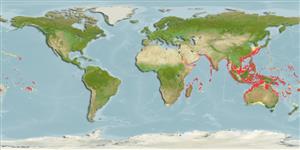Common names from other countries
Teleostei >
Elopiformes (Tarpons and tenpounders) >
Megalopidae (Tarpons)
Etymology: Megalops: Greek, megas, megalos = great + Greek, ops = appearance (Ref. 45335).
Environment: milieu / climate zone / depth range / distribution range
生态学
海洋; 淡水; 半咸淡水 底中水层性; 非产卵性溯降河的; 深度上下限 1 - 50 m (Ref. 86942). 熱帶; 34°N - 37°S, 16°E - 130°W
Indo-Pacific: Persian Gulf (Ref. 68964), Red Sea and Natal, South Africa (Ref. 3969) to the Society Islands, north to southern Korea, south to the Arafura Sea (Ref. 9819) and New South Wales. Restricted to high islands (Palau, Caroline and Mariana islands) in Micronesia. Reported as far inland as the lower Shire in Malawi and the Save-Runde junction in Zimbabwe (Ref. 7248, 52193). Widespread in the Lower Zambezi River channels up to Marromeu and in the Micelo River up to Malingapanzi (Ref. 39494). South China Sea, Taiwan Strait, and East China Sea(Ref.33302).
印度-太平洋: 紅海與南非的納塔爾 (參考文獻 3969) 到社會群島,北至韓國南部, 南至阿拉弗拉海 (參考文獻 9819) 與新南威爾斯。 在密克羅尼西亞侷限於高的島 (帛琉,加羅林群島與馬里亞納群島)了。 在辛巴威的馬拉威與 Save-Runde 合流處遙遠地在內陸被記錄為如雪利河下游了。 (參考文獻 7248) 廣泛分佈於三比河峽道向上到 Marromeu 下游與在 Micelo 河向上到 Malingapanzi 中.(參考文獻 39494)
Length at first maturity / 大小 / 重量 / 年龄
Maturity: Lm ?, range 25 - ? cm
Max length : 150 cm TL 雄鱼/尚未辨别雌雄; (Ref. 1479); common length : 30.0 cm SL 雄鱼/尚未辨别雌雄; (Ref. 7017); common length :45.5 cm SL (female); 最大体重: 18.0 kg (Ref. 13337); 最大年龄: 44 年 (Ref. 72487)
背棘 (总数) : 0; 背的软条 (总数) : 16 - 21; 臀棘: 0; 臀鳍软条: 23 - 31.
下颌突出超过吻; 一个骨质喉盘在颌硬骨之间呈现。 最后的背鳍鳍条长而丝状的; 腹地位于胸鳍; 腹部的腹鳍有 9个或更多鳍条。 鳃盖条超过 23. 鳞片大的。 背部蓝绿色; 银色的在侧边上。 能容忍缺氧的水被呼吸' 进入一个像肺一样的气管之内的空气。 也参考文献 3969.
Obligate air-breathing (Ref. 126274); Adults are generally found at sea, but young inhabit river mouths, inner bays, and mangrove forests. In freshwater, they occur in rivers, lagoons, lakes, and swampy backwaters (Ref. 2847, 44894). Tolerate a wide pH range (5.2-9.1) (Ref. 44894) and salinities from 0 to 100. Mainly diurnal (Ref. 7017). Predaceous, feeding mainly on fishes and crustaceans (Ref. 5213). Breed offshore, possibly throughout the year. Larvae are transparent and resemble larval eels (Ref. 13337), but with a forked tail (Ref. 167). Juveniles commonly enter freshwater (Ref. 44894, 48635) in clear or turbid water (Ref. 44894). Known to breath air, rising regularly to the surface to do so. Cultured in ponds, the fry being sourced from the coasts (Ref. 7050). Popular angling fish (Ref. 3969). Edible but not esteemed (Ref. 3969). Caught by gill nets, seines, and trawls, and by hook-and-line; marketed fresh and dried salted (Ref. 10982).
成鱼是通常发现于的海洋,但是幼鱼居住于河口,海湾内与红树林森林。 在淡水中,它出现于河,舄湖,湖与沼泽的洄水区中。 (参考文献 2847,44894) 容忍宽的酸碱度范围 (5.2-9.1)(参考文献 44894) 与盐度从 0 到 100 。 主要日行性.(参考文献 7017) 食肉的, 主要捕食鱼与甲壳动物.(参考文献 5213) 繁殖外海, 可能地全年度。 仔鱼是透明的而且与幼虫的鳗鱼相似。 (参考文献 13337) 稚鱼通常在清澈或混浊的水进入淡水 (参考文献 44894,48635) 。 (參考文獻 44894) 已知了呼吸空氣, 經常地對表面升起這麼做。 養殖在距離海岸被來源的池塘,魚苗中了。 (參考文獻 7050) 受歡迎的垂釣魚種.(參考文獻 3969) 可食用的但是不讚賞.(參考文獻 3969)
Life cycle and mating behavior
Maturities | 繁殖 | Spawnings | Egg(s) | Fecundities | 仔鱼
印度-太平洋: 紅海與南非的納塔爾 (參考文獻 3969) 到社會群島,北至韓國南部, 南至阿拉弗拉海 (參考文獻 9819) 與新南威爾斯。 在密克羅尼西亞侷限於高的島 (帛琉,加羅林群島與馬里亞納群島)了。 在辛巴威的馬拉威與 Save-Runde 合流處遙遠地在內陸被記錄為如雪利河下游了。 (參考文獻 7248) 廣泛分佈於三比河峽道向上到 Marromeu 下游與在 Micelo 河向上到 Malingapanzi 中.(參考文獻 39494)
Whitehead, P.J.P., 1984. Megalopidae. In W. Fischer and G. Bianchi (eds.) FAO species identification sheets for fishery purposes. Western Indian Ocean fishing area 51. Vol. 3. [pag. var.]. FAO, Rome. (Ref. 3463)
CITES (Ref. 128078)
Not Evaluated
人类利用
渔业: 低经济; 养殖: 商业性; 游钓鱼种: 是的
工具
特别资料
下载 XML
网络资源
Estimates based on models
Preferred temperature (Ref.
115969): 19.8 - 27.6, mean 24.4 (based on 501 cells).
Phylogenetic diversity index (Ref.
82804): PD
50 = 1.0020 [Uniqueness, from 0.5 = low to 2.0 = high].
Bayesian length-weight: a=0.00741 (0.00532 - 0.01033), b=3.07 (2.97 - 3.17), in cm Total Length, based on LWR estimates for this species (Ref.
93245).
营养阶层 (Ref.
69278): 3.5 ±0.1 se; based on diet studies.
回复力 (Ref.
120179): 中等的, 族群倍增时间最少 1.4 - 4.4年 (Assuming tm<=4).
Prior r = 0.57, 95% CL = 0.37 - 0.85, Based on 2 data-limited stock assessments.
Fishing Vulnerability (Ref.
59153): Very high vulnerability (90 of 100).
Climate Vulnerability (Ref.
125649): High to very high vulnerability (75 of 100).
